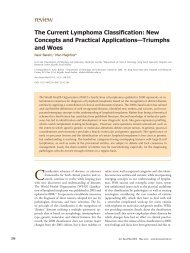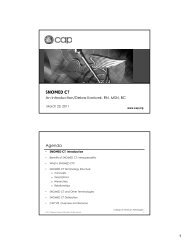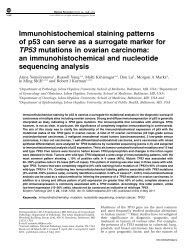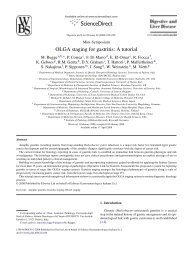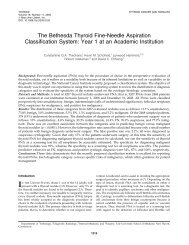Morphological subtypes of ovarian carcinoma: a ... - BPA Pathology
Morphological subtypes of ovarian carcinoma: a ... - BPA Pathology
Morphological subtypes of ovarian carcinoma: a ... - BPA Pathology
Create successful ePaper yourself
Turn your PDF publications into a flip-book with our unique Google optimized e-Paper software.
SUBTYPES OF OVARIAN CARCINOMA 421Table 1 Relative frequencies <strong>of</strong> <strong>subtypes</strong> <strong>of</strong> <strong>ovarian</strong> <strong>carcinoma</strong> based on tworecent population based studies68–71% serous3% mucinous9–11% endometrioid12–13% clear cell1% transitional6% mixedvarious tumour types, morphological changes secondary tochemotherapy and tumour grading are covered.RELATIVE FREQUENCIES OF MAJORMORPHOLOGICAL SUBTYPES OF OVARIANCARCINOMAThe major morphological <strong>subtypes</strong> <strong>of</strong> <strong>ovarian</strong> <strong>carcinoma</strong> areserous, endometrioid, clear cell and mucinous. 6 Other <strong>subtypes</strong>include transitional, undifferentiated and mixed. Primary <strong>ovarian</strong>squamous <strong>carcinoma</strong>s also occur; these are rare, usuallyarise in a dermoid cyst or more uncommonly in association withendometriosis or a Brenner tumour, and will not be discussedfurther. Two relatively recent population based studies whichhave included central pathology review using modern diagnosticcriteria have provided updated information regarding therelative frequencies <strong>of</strong> the major <strong>subtypes</strong> <strong>of</strong> <strong>ovarian</strong> <strong>carcinoma</strong>7,8 (Table 1). It can be seen that serous is the mostcommon, followed by clear cell and endometrioid which occurwith approximately equal frequency. Mucinous <strong>carcinoma</strong>s areless common. This represents a change from most older studieswhere mucinous <strong>carcinoma</strong> was the second most commonsubtype and accounted for approximately 12% <strong>of</strong> primary<strong>ovarian</strong> <strong>carcinoma</strong>s, 9 a much higher frequency than in thetwo recent studies; reasons for this decline in the frequency<strong>of</strong> mucinous <strong>carcinoma</strong> are discussed later. The two studies alsoindicate an increase and decrease in the frequency <strong>of</strong> serous andendometrioid <strong>carcinoma</strong>, respectively; this is likely a reflection<strong>of</strong> the fact that the distinction between a high grade serous andhigh grade endometrioid <strong>carcinoma</strong> was previously poorlyreproducible 10–14 and there is now a realisation that manyneoplasms which were previously diagnosed as advanced stage,high grade endometrioid <strong>carcinoma</strong> were, in fact, <strong>of</strong> serous type(discussed later). When divided into early stage (stage I–II) andlate stage (stage III–IV), it can be seen that serous, clear celland endometrioid <strong>carcinoma</strong>s are approximately equallyrepresented in early stage, nearly all mucinous <strong>carcinoma</strong>sare early stage and a very high percentage <strong>of</strong> advanced stageneoplasms are serous in type (Table 2). Put another way, a highpercentage <strong>of</strong> clear cell, endometrioid and mucinous <strong>carcinoma</strong>sare diagnosed at early stage and in fact these tumourtypes (especially endometrioid and mucinous) are usuallyconfined to the ovary at diagnosis (stage I).Table 2 Early stage (I/II) versus late stage (III/IV) distribution <strong>of</strong> <strong>subtypes</strong> <strong>of</strong><strong>ovarian</strong> <strong>carcinoma</strong> based on two recent population based studiesStage I/IIStage III/IVSerous 36% 88%Clear cell 26% 5%Endometrioid 27% 3%Mucinous 8% 1%MORPHOLOGICAL CHANGES IN OVARIANCARCINOMAS SECONDARY TOCHEMOTHERAPYFor many years, the traditional management <strong>of</strong> advanced stage<strong>ovarian</strong> <strong>carcinoma</strong> has been surgical debulking followed byadjuvant chemotherapy. However, in an increasing number <strong>of</strong>cases, upfront chemotherapy is administered, especially inpatients who are a poor operative risk or patients with miliarydisease or widespread metastasis where optimal debulking isnot considered feasible; chemotherapy may or may not befollowed by surgery. The morphological features <strong>of</strong> <strong>ovarian</strong><strong>carcinoma</strong>s treated by chemotherapy <strong>of</strong>ten differ markedlyfrom native tumour. 15,16 Post-chemotherapy, many <strong>ovarian</strong><strong>carcinoma</strong>s (the vast majority will represent serous <strong>carcinoma</strong>ssince almost all advanced stage <strong>ovarian</strong> malignancies are <strong>of</strong> thismorphological subtype) have abundant clear or eosinophiliccytoplasm and the nuclear features are <strong>of</strong>ten bizarre withmultinucleate tumour giant cells 15,16 (Fig. 1). There may beno residual tumour or it may be difficult to identify residualneoplastic cells due to pronounced chemotherapy effect withmarked fibrosis, necrosis, inflammation, cholesterol cleft formation,haemosiderin deposition and dystrophic calcification.Unless there is no or minimal response, it can be very difficultto type an <strong>ovarian</strong> <strong>carcinoma</strong> following chemotherapy and thereis a tendency to misdiagnose some as clear cell <strong>carcinoma</strong> dueto the abundant clear cytoplasm. 15,16 If upfront chemotherapy isbeing administered, a pre-chemotherapy tissue biopsy (usuallya percutaneous radiologically guided biopsy or a biopsy takenat laparoscopy) should be obtained for definitive typing, apartfrom in exceptional circumstances, rather than relying oncytology <strong>of</strong> the ascitic fluid in combination with serumCA125 levels and imaging. The procurement <strong>of</strong> a tissue biopsy,as well as facilitating tumour typing and excluding a metastasisfrom other sites, means that material is available for futurestudies and research; for example, targeted therapies may bedeveloped against specific proteins and if tissue is available thiswill be useful in assessing whether the target protein is presentin the tumour cells. Tissue obtained at different stages intreatment may also be useful in assessing tumour progressionand response to therapy.GRADING OF OVARIAN CARCINOMASSeveral grading systems are used for <strong>ovarian</strong> <strong>carcinoma</strong> butgrading is <strong>of</strong>ten poorly performed by pathologists and in manystudies the grading system used has not been specified. 17–19Most <strong>of</strong> the grading systems are universal in that they can beapplied to all the major morphological <strong>subtypes</strong> <strong>of</strong> <strong>ovarian</strong><strong>carcinoma</strong>; 17–19 for example, the Shimizu-Silverberg system isbased on the Nottingham grading system for breast <strong>carcinoma</strong>and uses three parameters, namely the degree <strong>of</strong> nuclear atypia,the mitotic count and the architectural features, specifically theamount <strong>of</strong> glandular, papillary or solid growth. 17 Eachparameter is given a score <strong>of</strong> 1–3 and a grade is derived basedon the summation <strong>of</strong> the scores. However, although manypathologists use this or other universal grading systems, suchas FIGO or World Health Organization (WHO), there is anincreasing tendency to employ different grading systems fordifferent morphological <strong>subtypes</strong> <strong>of</strong> <strong>ovarian</strong> <strong>carcinoma</strong>; thispractice has been recommended in the Royal College <strong>of</strong>Pathologists Ovarian Cancer Datasets in the United Kingdom. 20Grading <strong>of</strong> the different <strong>subtypes</strong> <strong>of</strong> <strong>ovarian</strong> <strong>carcinoma</strong> isdiscussed with each specific tumour type.Copyright © Royal College <strong>of</strong> pathologists <strong>of</strong> Australasia. Unauthorized reproduction <strong>of</strong> this article is prohibited.




